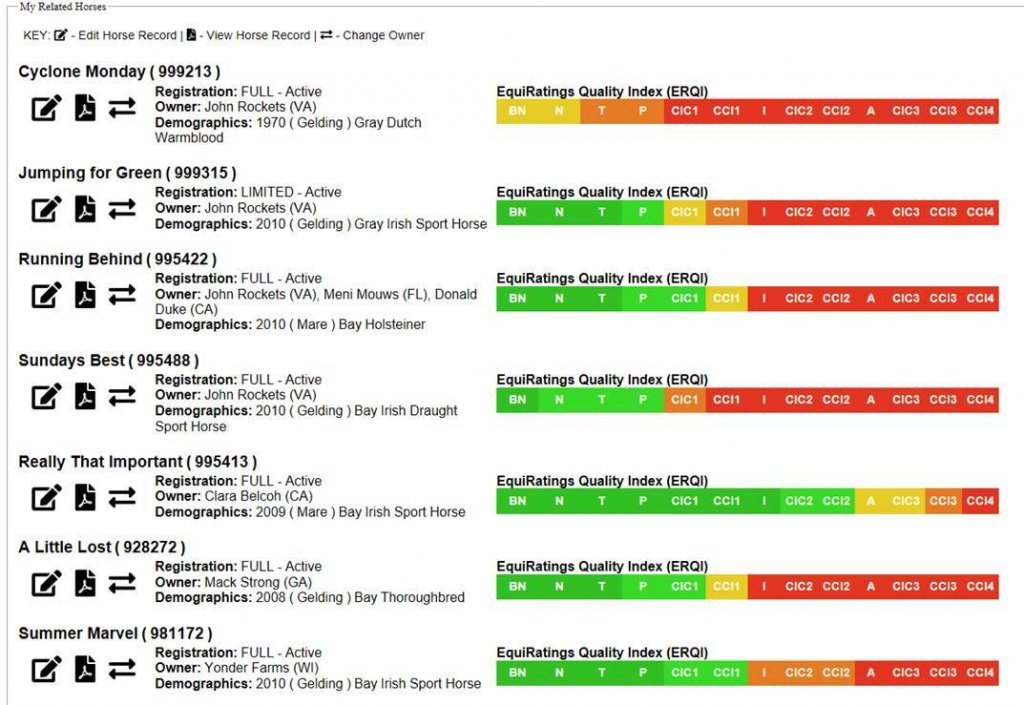EquiRatings Quality Indexes (ERQIs) Now Available on USEA Horse Profiles

Last spring the United States Eventing Association (USEA) announced a new partnership with EquiRatings. Following eight months of behind-the-scenes work, EquiRatings Quality Indexes (ERQIs) are now available for all USEA registered horses who have competed in the last five years.
After a very successful rollout of the system in Ireland over the last two seasons, the USEA will be the second country to utilize the ERQI risk management tool. It will also be implemented in Britain and Australia in various ways over the coming seasons.
The ERQI is a risk management tool that assigns a value to each USEA competing horse. The ERQI is calculated as a probability, a number between 0 and 1, with horses closer to 1 showing statistically higher levels of positive performance in the cross-country phase. ERQIs are displayed on each horse’s profile in a color code representing the level of risk the horse carries on cross-country. The ERQI is built on the ‘data footprint,’ (the past results) of each horse, and applies a marginal gains approach to improving fall rates.
The ERQI system will allow USEA members to track and monitor risk in a tangible way. The USEA is committed to safety and this partnership with EquiRatings will ensure continuing assessment of the performance data. By providing every horse, at every level, with an ERQI, riders will have a visual indicator of risk at each specific level. Rider responsibility is a huge part of making eventing safer and the ERQI is another tool to make decisions easier for riders. One of the key advantages of the ERQI system is the removal of subjectivity from the assessment of risk.
A horse’s ERQI will only be displayed for associated riders or owners. To view a horse’s ERQI, login to USEA Online Services. Once logged in, click on “My Related Horses” in the Horses section of the home screen dashboard. If you want to view an ERQI for a horse that you are not currently related to, you will need to add yourself as a rider or owner to the horse’s record. This addition may require contacting the owner to make the change or submitting a change of owner request with proper bill of sale documentation.

Each color represents the grouping of risk which the horse falls into. The USEA will display this probability in groupings and by color code (red, orange, yellow and green).
Green/Light Green: Horse at this level is competing with the normal amount of risk.
Yellow: Horse at this level is competing with a slightly higher level of risk than normal.
Orange/Amber: Horse at this level is competing with a much higher level of risk than normal.
Red: Horse at this level is competing with the highest level of risk.
The ERQI is being used solely as an advisory tool in 2018. The USEA has no requirement for a horse to have a green ERQI to enter an event at the level in question. The ERQI should be treated as a guideline and the USEA strongly recommends that riders use the ERQI and all the other tools at your disposal to make safe and informed decisions.
The USEA and EquiRatings have put together a full list of questions about the use and availability of ERQIs. The document is available here.
The USEA and EquiRatings will be releasing a number of addition resources, including a podcast and Q&A vidoes later this week through the USEA website to help build an understanding of this new risk management system.
For technical questions about the ERQI system (can’t find my horse’s ERQI, etc.) please contact [email protected].














